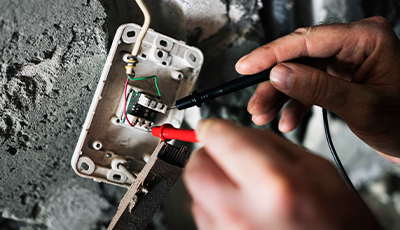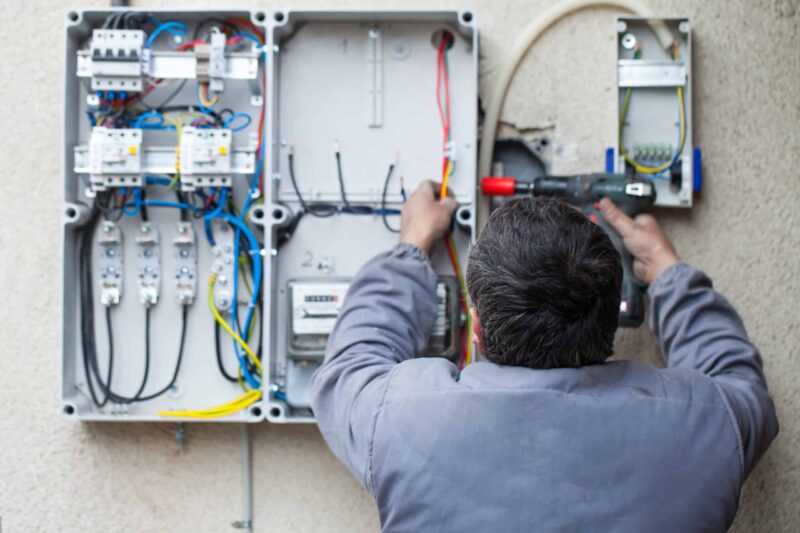Common Electric Problems Every Property Owner Need To Find out about
Home owners typically come across various electrical troubles that can impact safety and security and functionality. Issues like flickering lights and stumbled breaker are much more usual than many realize. These scenarios can suggest much deeper electrical issues that warrant interest. Recognizing the indications and threats connected with obsolete wiring and dead outlets is essential. What actions can be taken to stop these issues? Discovering these common electrical problems can expose important insights for keeping a secure home setting.

Flickering Lights: Causes and Solutions
Why do some home owners experience flickering lights? Flickering lights can be a common annoyance, usually suggesting underlying electrical issues. One key cause is malfunctioning or loosened links within lighting fixtures or circuitry, which can bring about periodic power supply. In addition, making use of high-wattage devices on the very same circuit may create voltage changes, resulting in dimming or flickering. One more possible issue is an overloaded circuit, where as well numerous gadgets attract power concurrently, stressing the electrical system. Additionally, out-of-date or degraded electrical wiring can add to inconsistent electrical flow. In many cases, flickering lights may signify a problem with the home's electric panel or service line. Homeowners must deal with flickering lights quickly to stay clear of potential threats. Solutions might include tightening up links, redistributing device tons, or speaking with a licensed electrician for an extensive assessment. Recognizing the source can help assure a steady and safe electric system in the home.
Tripped Circuit Breakers: What You Required to Know
Have homeowners ever before wondered what creates their breaker to journey all of a sudden? This usual problem usually develops from an overload of electric circuits, where a lot of tools draw power all at once. In such cases, the circuit breaker acts as a security system, interrupting the circulation of electricity to protect against getting too hot and potential risks. One more constant reason is a short circuit, which occurs when a real-time wire contacts a neutral cable, producing a surge of electricity that trips the breaker. Ground faults can additionally lead to stumbled breakers; these take place when an online cable touches the ground or a based surface, positioning major safety dangers. Home owners need to on a regular basis analyze their use of high-wattage devices to prevent straining circuits. Additionally, understanding the feature of circuit breakers can aid them react properly throughout a trip, ensuring their home continues to be secure and well-kept.
Out-of-date Circuitry: Signs and Threats
Out-of-date wiring can pose considerable risks to property owners, often going undetected till troubles arise. Houses built before the 1980s might still have light weight aluminum wiring or knob-and-tube systems, which are no more considered risk-free. Indicators of outdated wiring include flickering lights, frequently tripped breaker, or melting smells near electrical outlets. These signs might recommend that the electrical system is overburdened or deteriorating.Additionally, house owners could see blister marks around switches or electrical outlets, which can indicate getting too hot. The threat of electrical fires markedly raises with outdated wiring, as these systems were not developed to manage modern electric lots. Homeowners are motivated to have their wiring examined regularly, especially when renovating or including brand-new appliances. By recognizing these indications early, they can avoid dangerous circumstances and keep a safer living setting. Updating to current electrical standards is a positive action in preserving home safety and performance.
Frequently Blown Fuses: Troubleshooting Tips
Frequent blown integrates can suggest underlying electrical concerns that might come from outdated circuitry or overloaded circuits. Property owners experiencing this problem must initially recognize the devices linked to the impacted circuit. It is advisable to prevent utilizing several high-wattage devices concurrently, as this can lead to circuit overload. If the issue continues, evaluating the circuit box for indicators of wear or damage is essential; a damaged fuse box might need replacement.Additionally, checking for loose links within the circuit can aid avoid future occurrences. Homeowners must also confirm that the merges being made use of are of the right amperage, as utilizing an inaccurate fuse can worsen the trouble. If these fixing tips do not resolve the issue, seeking advice from an accredited electrician is advised to evaluate the you can look here electric system better. Dealing with these concerns promptly can assist alleviate threats and assure the safety and security of the home's electric infrastructure.
Dead Outlets: Usual Causes and Fixes
When a homeowner runs into a dead outlet, it can usually be a source of aggravation and complication. A number of common causes might lead to this issue. One constant culprit is a tripped breaker, which can be easily reset. If any type of breakers are in the off setting, house owners should inspect their electric panel to examine. An additional opportunity is a defective electrical outlet itself, which might require replacement. Additionally, loose circuitry connections within the electrical outlet can interrupt power flow, making evaluation essential.Sometimes, the issue may stem from an overloaded circuit, particularly when numerous tools are attached. In such situations, rearranging the electric load can fix the problem. Homeowners should additionally think about the age of their circuitry; older systems may require updates to fulfill modern-day electric needs. If these steps do not remedy the circumstance, getting in touch with a qualified electrical expert is advisable to guarantee security and correct medical diagnosis.
Electrical Shocks: When to Be Concerned
How can property owners establish whether an electric shock warrants concern? Homeowners should first examine the intensity and context of the shock. A mild fixed shock, typically really felt when touching metal objects, is usual and typically harmless. However, if the shock takes place while communicating with a plugged-in home appliance or electrical outlet, it might suggest an extra significant issue.The place and regularity of the shocks are essential. Repeated shocks from the very same resource, specifically in wet areas like kitchens or washrooms, can signify malfunctioning electrical wiring or insufficient grounding. Home owners need to also take into consideration the experience of the shock; a jolt that triggers discomfort or muscle contractions is much more disconcerting than a simple tingle.If there's any kind of unpredictability, it is advisable to speak with a certified electrician. Overlooking prospective electric risks can bring about major security risks, consisting of fire or severe injury.
Overloaded Circuits: Prevention and Safety And Security Steps
Overloaded circuits present significant risks in residential setups, often resulting in electrical fires or tools damage (Accredited Service Provider Level 2 Electrician). Homeowners must recognize the indicators of an overloaded circuit, such as regularly stumbled breakers or dimming lights. Carrying out preventative safety methods can assist alleviate these risks and guarantee a much safer living setting
Recognizing Overloaded Circuits
What indicators show that a circuit may be strained? Homeowners must be vigilant for several key indicators. Regularly stumbled circuit breakers or blown integrates recommend too much lots on the circuit. Dimming or flickering lights, especially when other appliances are in usage, can indicate an inadequate power supply. Additionally, electrical outlets or switches that feel cozy to the touch might suggest overheating, a possible fire hazard. Unusual humming sounds from outlets also necessitate attention, as they can indicate electric concerns. Ultimately, if home appliances operate inefficiently or stop working to begin, it may suggest an overloaded circuit. Recognizing these indicators early can aid stop major electrical issues and promote a safer home environment.
Preventive Security Practices
To keep a effective and safe electric system, house owners have to implement preventive safety and security methods that resolve prospective circuit overloads. One reliable measure is to stay clear of connecting way too many devices to a solitary outlet, as this can surpass the circuit's ability. Making you can try here use of power strips with integrated circuit breakers can help distribute power securely. Homeowners ought to also on a regular basis check cables and devices for damage and change any type of malfunctioning equipment immediately. It is crucial to ensure that breaker are operating properly and to be familiar with the overall power level being used in each circuit. Additionally, consulting an accredited electrical expert for routine assessments can identify prospective concerns before they rise, assuring a more secure living setting and prolonging the life-span of electrical systems.
Regularly Asked Concerns
Exactly how Typically Should I Have My Electrical System Inspected?
Regular examinations of electric systems are advised every 3 to five years. Home owners need to take into consideration extra constant checks if they experience problems, carry out remodellings, or stay in older residential or commercial properties to guarantee safety and security and compliance.
Can I Repair Electrical Troubles Myself or Work With a Specialist?

What Are the Indications of an Electric Fire Danger?
Signs of an electric fire danger consist of regularly tripped circuit breakers, flickering lights, burning smells, blemished electrical outlets, or warm, buzzing cables. Home owners must continue to be watchful and look for expert support if any one of these indications exist.
Just how Do I Know if My Home Demands an Electrical Upgrade?
To establish if a home requires an electrical upgrade, indicators consist of frequent breaker trips, out-of-date circuitry, insufficient electrical outlets, flickering lights, and the existence of older electric panels, suggesting potential safety and security threats and inadequacy.
Exist Particular Safety Tips for Do It Yourself Electrical Job?
When thinking about DIY electrical work, one should always switch off power, make use of insulated tools, confirm circuit functionality, comply with regional codes, and get in touch with professionals for complex tasks to ensure safety and security and protect against crashes. One more possible issue is an overloaded circuit, where also lots of devices attract power simultaneously, stressing the electrical system. The danger of electrical fires substantially raises with out-of-date electrical wiring, as these systems were not made to more deal with contemporary electric loads. Regular blown integrates can indicate underlying electric problems that might stem from outdated circuitry or overloaded circuits. To preserve a reliable and risk-free electrical system, property owners have to execute preventative security practices that address prospective circuit overloads. Level 2 Electrician Sydney. Indications of an electrical fire threat include often stumbled circuit breakers, flickering lights, burning odors, discolored outlets, or cozy, buzzing cables